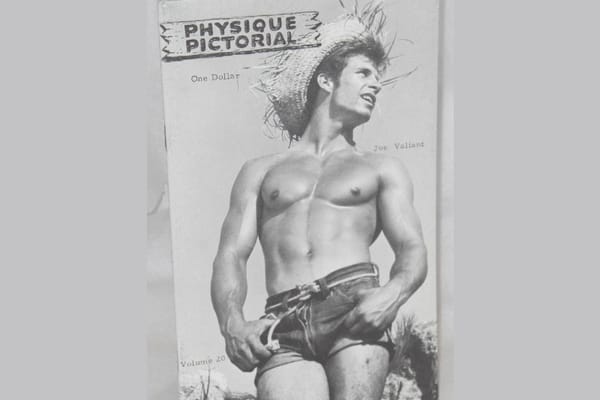What to watch: Paul and Trisha - the art of fluidity
Exploring the colourful careers of Paul Whitehead and Trisha Von Cleef.

A documentary by Fia Perera, Paul & Trisha: The Art of Fluidity explores the creative duality of Paul Whitehead and Trisha Van Cleef.
The focus of the film is initially on the story of Paul Whitehead - a painter, graphic designer, writer, and musician who worked as an art director for Time Out and John Lennon, and was known for creating album covers for bands such as Genesis and Credence Clearwater Revival.
Whitehead has been exploring his gender identity since the 1960s, but it wasn't until 2004 when Trisha Van Cleef emerged as a fully articulated alter ego. Trisha also paints but has a very different aesthetic to Paul.
"As a filmmaker and activist, my passion is spotlighting and elevating individuals like Paul and Trisha, who navigate their gender fluidity and duality with great freedom..." explains Fia Perera. "My mission with this film is to help inspire other people who are struggling to be their true selves to take the leap!”
We caught up with Paul Whitehead/Trisha Van Cleef to talk about the film.
How did you feel when the opportunity to participate in the documentary was first presented to you?
This didn’t originally start out as a full length documentary. Before Covid we were doing a series of pop up art shows, taking vacant retail spaces and doing two or three week-long art shows in them.
I decided that we needed a 20-30 minute movie that would play on a loop, talking about the work and my creative life - like the movies you see in museums during the exhibits.
I was already doing my Paul & Trisha “One Man – One Woman” art shows and I thought that the work needed a narrative for those that didn’t know the idea behind the show and about me as a transgender artist.
Were you ready to share your story with the world in this way?
I was more than ready. I've always tried to be very honest and forthright about my work and my creative intentions. Lots of artists like to be mysterious, intellectual and obtuse about their work and creative process - this has never appealed to me.
I think my early days as a graphic artist working with bands and designing their record covers taught me a much more pragmatic and down-to-earth approach to making art and using graphic design and art as a powerful communication tool.
I also felt that the world had kind of caught up with me. I remember the first time I heard the expression “Trans Gender”. I said to myself, ”Hey I’m one of those.”
It was like the world had found a respectful, empowering and non-incendiary way of describing “us”. I didn’t like terms like Sissy, Transvestite, or even Crossdresser - they all seemed like terms of reference that were historically loaded with negativity and judgement.
After a couple of interviews with Fia - the director of the film - it became clear that this was much more than a short film we were making.
Was the filming process something you felt comfortable with?
I felt very comfortable. I’ve done many interviews and, from past experiences, know the potential pitfalls.
I know that very often a journalist who interviews you has already formed an opinion about you and has basically written the article, in his mind, before you ever get together. So, when the answers you give do not conform with their pre-formed idea of you, they will try to put words in your mouth by asking very slanted questions that can only be answered in one way.
Fia was not like that - there was a genuine interest in me and she was intrigued by my creative process and my work and, because of this, she asked me some very original and interesting questions. I soon felt very comfortable with her.
I also figured, what the hell was there to lose by being vulnerable and honest at my age?
As we worked together, I told Fia that I was aware that me being honest and open about my journey gave the film the great potential to help others who were struggling with their gender identity - to perhaps encourage them to express themselves honestly and openly, and ask questions of those who had trodden the path before them.
There is a lot of experience out there - you are not alone.
Did the process of filming the documentary give you any fresh perspectives on your life or work?
Several times, Fia's questions shook me because she asked me a question about some aspect of my life that I’d never considered or thought to ask myself.
You have to understand that - like everyone else in this world - I was just living my life day by day, making my living by creating and selling my art, dealing with life’s ups and downs, and doing my best to stay on track. I’m not a very politically motivated person, I think my work – as a diary of my life – expresses of all of that for me.
But the more Fia and I talked, I realised that my life was quite original. I hadn’t really noticed this before because I was too busy just living life.
Sometimes, in the past, opportunities would come to me that were lucrative but very worldly and they didn’t make sense to me artistically or spiritually so I would turn them down - it was like my creative drive was a guided missile that could not be diverted from its target.
Funny thing is, I can really only see this now - through the lens of time and by being able to look back at my life through the story told in the documentary.
The interesting thing is that the story hasn’t ended yet – I’m always interested in “What’s next?”
What advice or guidance would you give to young artists trying to figure out how to make work in an authentic way?
I think the most important aspect of making any art is honesty, be yourself and express yourself in your own unique way - there is and will only ever be one You.
Don’t be swayed by fashions and trends, they come and go very quickly. Look at and listen to Yourself and you will find a unique angle on life within you that excites you and gives you the inspiration and energy to create in whatever sphere you decide is your medium.
Whether it’s art, music, writing, acting, film making, cooking, and even sports, they are all valid creative pursuits and there are millions of unique voices out there yet to be heard.
Don’t be afraid of the tomatoes of criticism being thrown your way either. If you don’t want to be controversial keep your head down, don’t make waves and you won’t get any tomatoes. On the other hand, you should celebrate the tomatoes because it means that your creations have ruffled some feathers, they’ve aroused passion and dialogue and this inevitably means change. Change - as part of the human experience - is the one thing we cannot stop.
What do you hope that people feel when watching this documentary about you, your work, and your identity?
I watched it a couple of weeks ago - with an audience - and I was able to see it, not as me, but through the eyes of someone not knowing anything about me or the world of the artist.
It felt like someone had cracked a door open, looked at my life and said to themselves, “Wow! That’s interesting, I didn’t know artists lived that kind of life.”
I also hope it empowers others to be honest, brave, and to live their own unique reality.
I hope that my work - both Paul and Trisha’s - inspires, motivates and amuses viewers so that they feel better about their lives and the future.
I am also very pleased with the way Fia dealt with the spiritual aspect of my life - a big part of my identity - because it could have turned out to be a Hippy Dippy kumbaya mess, just asking for misinterpretation. Instead, it is an honest and sensitive portrayal of a spiritual life as opposed to the constrictions and dogma of the religious way.
Paul & Trisha: The Art of Fluidity will be released on 9 July









